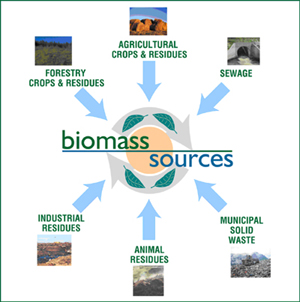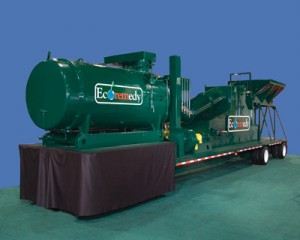 These days, when one thinks about clean energy, solar and wind power most likely come to mind first while geothermal and wave power may not be too far behind.
These days, when one thinks about clean energy, solar and wind power most likely come to mind first while geothermal and wave power may not be too far behind.
However, the other growing source of clean energy that is plentiful, available and producing jobs is Biomass Energy. Right now its proponents are working hard towards making the industry a major player in the clean energy sector.
Until recently, the emerging biomass industry has been somewhat below the radar in the public realm. One may ask why the mass media hasn’t promoted biomass as a major renewable energy source as they certainly have done when showcasing solar and wind energy.
Recently, Science Creative contacted Richard Madeira, Vice President of Enginuity Energy in Pennsylvania. He offers an explaination, “One reason may be that biomass fuels just aren’t sexy and the sector itself isn’t as well organized as the others. However, once people sit down and learn the facts, they always say – ‘Wow’!”
Quick Facts 
The Biomass Power Association (BPA) provides detailed facts and valuable information about biomass energy. However, the non-sexy aspects Mr. Madeira refers to consist of agriculture waste such as plants, animal manure and animal mortality. Then there is manufacturing refuse such as waste wood and timber slash. There is also food-processing refuse from food manufacturers and municipal waste.
Public Understanding
The Wausau Daily Herald reported a recent public meeting held in Wisconsin for a proposed biomass plant, whose purpose will be supplying electricity for a paper mill, revealed that many residents were undecided going into the meeting. However, at the meetings conclusion the attendees were apparently satisfied with the answers.  “No one particular issue stood out,” remarked Barry McNulty, a spokesman for We Energies at the event. “Residents asked very good questions… and we tried to give them a better understanding of what we do and how we do it.” Since the plant was proposed in September 2009, the company has tried to get ahead of critics with direct mailings, community meetings and door-to-door consultations.

The Advantages of Biomass Energy
From a marketing perspective, there are numerous reasons why the Wow factor that Mr. Madeira mentioned comes into being and one of the most significant advantages is the cost effectiveness of biomass energy. For one thing, the energy is generated and supplied in the same area; therefore installation of large power transmission lines is unnecessary. Secondly, the produced energy may also be converted into federally approved tax credits and sold as renewable energy credits.
In addition to the electricity generation, disposal of biological waste cuts down on the levels of the expulsion of carbon and methane into the atmosphere. Thus, it maintains an ecological balance of carbon present in the environment. Mr. Madeira pointed out that his company’ system will be carbon neutral and that the resultant ash will also be an excellent source of natural fertilizer as well as a nutrient-rich feed supplement.
Job Creation
Moreover, let’s not forget about job creation. The National Renewable Energy Laboratory reports the creation of 4.9 jobs for every megawatt of biomass power produced. Also, according to the BPA, biomass power generates ten times the number of good-paying jobs found at the typical natural gas-fueled facility.
One Company’s Mission
Enginuity Energy is currently in the planning phase of developing scalable regional powerplants that will run entirely on biomass fuel sources. Sources include chicken litter, spent mushroom substrate (SMS) and other naturally occurring high moisture content materials. The company has recently undergone a strategic merger with rem engineering of Roswell, Georgia the developer and patent holder of ecoremedy™gasification technology.
Mr. Madeira stated that “by using the ecoremedy™ technology these biomass waste materials can be gasified at temperatures reaching as high as 2,400° F and can handle moisture content up to 63%. The net result is smokeless, low dioxin and odorless steam emissions that will run turbines in renewable energy plants that can be scalable for either small industrial consumers or for larger stand-alone green power plants.† To date, the ecoremedy™ technology has completed successful pilot plant operations at a Tyson Foodsfeed mill in Bolivar, Georgia.
Mr. Madeira also commented, “site selection will be a key factor in developing these green power plants because they must be close to the fuel source in order to maximize efficiencyâ€. The plan is to locate the plants in non-urban areas that are also close to water, good roads and the power grid.
Marketing Biomass Energy
 The fact is biomass energy is no longer an unknown source of renewable energy and potentially can be a keystone to US national policy on clean energy, taking meaningful action on climate change and reducing its dependence on foreign oil.
The fact is biomass energy is no longer an unknown source of renewable energy and potentially can be a keystone to US national policy on clean energy, taking meaningful action on climate change and reducing its dependence on foreign oil.
Billions of dollars are at stake and yet it appears that the marketing efforts continue to lag behind. Whether it’s solar energy or wind power, the marketing challenges are the same for all of these energy sources and particularly so for biomass energy.
Therefore, in addition to having industry professionals speaking at public and private meetings, the biomass industry needs an effective marketing strategy that will deliver a consistent message to help propel the benefits to the forefront of public discussion.
The biomass industry message should be clear and concise while emphasizing closing the loop of sustainability by taking natural waste products and converting them to viable, clean and plentiful energy.
This post can also be viewed at: Science Creative


